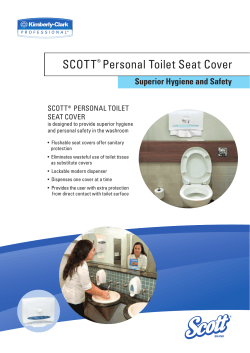
H o w
How to Check for a Water Leak If you receive an unusually high water bill and cannot substantiate an increase in your water consumption, you more than likely have a leak. The best method for determining whether or not a leak exists is to take actual water meter readings. This method will check your internal plumbing system for water leaks. You will need to locate your water meter and record the meter’s numeric reading just before going to bed, or when no water use will occur for several hours. Take another water meter reading in the morning before any water use, or after several hours of non-usage. In theory, the two meter readings should be identical. If they are not and you cannot account for any water usage, you have a leak. (Don’t forget about water usage from humidifiers, heating systems, icemakers or your water softener. These type appliances can use water without human involvement.) Damaging water leaks in your home are often quite easy to identify and fix. Major breaks in water pipes are noticed right away. What you may not realize is there can be many hidden leaks you cannot so easily detect unless you are looking for them. Even the smallest leaks result in large amounts of water losses because they occur 24 hours per day and they generally get worse, not better, when ignored. By following these simple steps, you should be successful in detecting the most common water leaks in the home that could save you money when corrected. Leaky faucets and showerheads are a major waste of water. One slow dripping faucet can waste up to 20 gallons of water a day. Repairing faucets can be as simple as shutting off the water supply to that particular faucet, and replacing the faucet’s washer. If you feel you need some assistance in doing this consult with a qualified plumber for advice or help. The toilet is one of the most common water wasters but its leaks tend to be less noticeable than faucet leaks. To determine if your toilet is leaking, look at the toilet bowl after the tank has stopped filling. If water is still running into the bowl, or if water can be heard running, your toilet is leaking. Most toilet leaks occur at the overflow pipe or at the plunger ball inside the tank. To locate a toilet leak, take the tank lid off and flush. The water level should come up to about a half inch or so below the top of the overflow pipe. If water flows into the overflow pipe, adjust the float level control screw or control rod. If the valve itself is leaking, you may need a plumber to fix it. Although water may not be seen or heard running, your toilet may have a silent leak. To test for a silent leak, drop a little food coloring into the tank. DO NOT FLUSH. Wait for about 10 minutes. If the food coloring appears in the toilet bowl, your toilet has a silent leak. It is probably located in or around the plunger ball or flapper valve at the bottom of the tank. These leaks are easy to fix with parts from your local hardware or home store. Do not forget to inspect your outside faucets, sprinkler systems and garden hoses. It’s easy to overlook a hose that was not turned off completely. Thousands of gallons of water can be wasted that way in just over a period of a few short summer months. Another source of a leak could be your hot water tank. Check your tanks drain and pressure relief valves. Often times these valves are plumbed to your sewer line and when leaking, go unnoticed. If you suspect a leak and none were found by following the suggestions above, a thorough inspection of your pipes, lines, connections and valves, would be the next step. For more information, contact Carlisle Borough’s Water Department at 249-4422.
© Copyright 2025





















